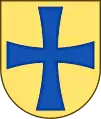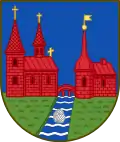Slagelse Municipality
Slagelse Municipality is a municipality (Danish: kommune) in Region Zealand on the west coast of the island of Zealand (Danish: Sjælland) in Denmark. The municipality covers an area of 571 km². The municipality borders Kalundborg Municipality to the north, Sorø Municipality to the north-east, Næstved Municipality to the south-east and connects to Nyborg Municipality via the Great Belt Bridge.
Slagelse Municipality
Slagelse Kommune | |
|---|---|
 Coat of arms | |
 | |
| Country | |
| Region | |
| Established | January 1, 2007 |
| Seat | Slagelse |
| Government | |
| • Mayor | John Dyrby Paulsen (A) |
| Area | |
| • Total | 567.34 km2 (219.05 sq mi) |
| Population (2020) | |
| • Total | 79,073 |
| • Density | 140/km2 (360/sq mi) |
| Time zone | UTC+1 (CET) |
| • Summer (DST) | UTC+2 (CEST) |
| Municipal code | 330 |
| Website | www.slagelse.dk |
The main city and the site of the municipal council is the city of Slagelse. The mayor has since 2017 been John Dyrby Paulsen, a member of the Social Democratic political party.
The municipality include the inhabited islands of Omø, Agersø and Glænø, as well as the uninhabited islands of Sprogø, Østerfed, Stenfed, Ormø, Fuglehøj, Sandholm, Kidholm and Fugleholm.
On 1 January 2007 the former Slagelse municipality was, as the result of Kommunalreformen ("The Municipal Reform" of 2007), merged with Hashøj, Korsør, and Skælskør municipalities to form an enlarged Slagelse municipality.
History
Slagelse has existed since the 1000s, and coins have been minted there since Cnut the Great's time. It was granted the status of market town by Eric V in 1288. Skælskør was given market town status in 1414. Korsør was granted the same status in 1425. While Slagelse and Skælskør were already important locations before becoming a market town, with the ring castle of Trelleborg located next to Slagelse, Korsør was a more insignificant town before becoming a market town. Korsør's location quickly made it an important town for ferry services to Nyborg on Funen. The three towns became competitors for the land and resources. Korsør's importance as a way to get to Funen allowed Korsør to be favoritized over Slagelse until the 1600s. The town remained small, but fared better than Slagelse, who was struggling. This was also linked to Korsør's access to the sea, giving them a variety of opportunities and privileges, including being able to ship out the grain from many farm areas on western Zealand, leaving them in conflict with the neighboring towns. Slagelse's economy was meanwhile mainly based on artisanry and tobacco. Skælskør was a lesser part of the conflict on western Zealand. [1][2][3] Through the middle ages the three towns remained market towns, with the remaining territory of the current municipality going under the administrative hundreds of Slagelse Hundred and Vester Flakkebjerg Hundred. These belonged to the syssel of Vestersyssel. In 1660 the syssel was changed and split up into two counties (Danish: amter). These were Antvorskov County and Korsør County, and they approximately made up the current borders of Slagelse Municipality. In 1798 these counties were merged with Sorø County. In the 1970 Danish Municipal Reform the administrative division of the region was changed again. Market towns were dissolved, and Slagelse instead became the seat of the new Slagelse Municipality. Korsør became the seat of Korsør Municipality, Skælskør of Skælskør Municipality and Dalmose of Hashøj Municipality. All four municipalities were in the new West Zealand County. In the Municipal Reform of 2007 these four municipalities were merged to form the current municipality, which became a municipality in the new Region Zealand.[4] Historical divisions
MayorsSince the 2007 municipal reform, the mayors of Slagelse Municipality have been:
TownsBelow are all settlements in the municipality with populations of at least 200 people (populations as of 2020).[5]
Slagelse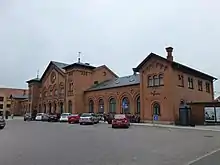 Slagelse Station. Slagelse is the largest city in the municipality, and is the seat of the municipal council. It is the 21st largest city in Denmark. The city's largest attractions include the sizable shopping center West Zealand Center (Danish: Vestsjællandscenteret), the ruins of Antvorskov and the nearby ring castle of Trelleborg. Slagelse is located around 15 km east of Korsør and 17 km north-east of Skælskør. 13 km east of Slagelse is Sorø, 33 km north is Kalundborg and 32 km south-east is Næstved. Slagelse borders a large forest area to the south-east, with the closest parts of the forest known as Slagelse Lystskov. Antvorskov barracks and the village of Harrested is located to the south, while the rest of the city borders fields. Antvorskov and the ruins of the Antvorskov Monastery is located in the southern part of the town, where a school and a large supermarket is also located. The police department of the municipality is also located in the southern part of the town, as is Antvorskov Church. The south-western part of the city consist of residential areas and a number of large shops. The western side of the town is mainly residential with a small industrial area. Also to the west, though closer to the center of the city, is Slagelse Gymnasium and the surrounding educations and schools, including a large vocational school. The hiking trail and former railway Fodsporet cut through the south and western parts of Slagelse. The northern parts of Slagelse have large residential and industrial areas, and is also the location of the Danish Welfarehistorical Museum, several schools and a vocational school. To the east is Skovsø, which is a village that has mostly grown together with Slagelse and is home to many industries. A golf course is also located in Skovsø. Next to Skovsø, at the south-east of Slagelse, are mostly residential areas, and further towards the town center is Slagelse Hospital. The center of Slagelse is the home to a large number of shops, restaurants, cafés and services. Slagelse Library, Slagelse Museum, Slagelse Train Station, the town hall and two churches are located around the center of the city. The West Zealand Center (Danish: Vestsjællandscenteret) is a shopping center originating from 1969 and is also located at the center of the town.[6] Korsør Korsør Fortification. Korsør is located on the south-western tip of Zealand, connecting to Nyborg through the Great Belt Bridge. The city is split in two by the Korsør Nor fjord. The northern half of the city is known as Halsskov, and is home to Korsør Train Station, located in the outskirts of Halsskov, near the village of Stibjerg Huse. Halsskov is home to a small industrial area, a harbour, Halsskov Church, a sizable camping and vacation center and a number of cultural facilities, including a library. The southern half of Korsør is known by the city's name, and is home to a naval base, a harbour, St Povls Church and a small industrial area. The Danish Maritime Authority has its headquarter in Korsør. Also located in the city is Korsør Fortification (Danish: Korsør Fæstning), where a castle from the 1200s used to be located. It was torn down in the start of the 1800s, but the fortifications remain.[7] Skælskør Skælskør Library. Skælskør is located south-east of Korsør and south-west of Slagelse. It borders the fjord of Noret, which goes through the town and split it in two. Skælskør Church is located in the western part of the town. In the eastern part is a sizable industrial area. Denmark Bus Museum is located in Skælskør. The village and beach of Kobæk Strand is located 1 km west of Skælskør. Forlev-VemmelevForlev-Vemmelev (also known under the individual names Forlev and Vemmelev) are two towns that have grown together. The merged town is referred to under all three names. The Statistics Denmark refer to the town as Forlev while Slagelse Municipality refer to it as Vemmelev. The E20 motorway cut through the town, with the former Forlev located north of the motorway and Vemmelev south of it. A bridge connects the two sides of the town. Vemmelev Church is located in Vemmelev. VillagesThe large size and population of the municipality mean that there are many small villages and settlements in the municipality.  Omø Harbour in Kirkehavn. Slots Bjergby is a village located ca. 2 km south of Slagelse. The village, which has also had the names of Bjergby and Munke Bjergby, is home to the highest located church on Zealand, 77.5 meters above sea level.[8] Fladholte is a small village located 12 km south-east of Slagelse. The village is located on the border to Næstved Municipality. In the village is the largest private collection of military vehicles in the Nordic Countries, in a museum called PanzerMuseum East. The museum display various types of military vehicles, two helicopters and a Bac 1-11 passenger plane is also displayed in the museum. [9] Årslev is located 6 km north of Slagelse. Outside the village, to the east, is a permanent circus and amusement park called Arena Cirkusland, home to Cirkus Arena. [10] Omø By is the main settlement on the island of Omø, with the other settlement on the island called Kirkehavn (or Omø Kirkehavn). Omø Church is located in Omø By.[11] The main settlement on the island of Agersø is called Agersø By. Agersø Church and Agersø Mill are located here.[12] The island of Glænø is inhabited, though there are no named settlements on the island. In addition to these villages, there are a number of smaller settlements in the municipality. These are all the settlements with populations of less than 200 people:[13]
Nature.jpg.webp) Tude Å. Most of the land in the municipality are used for agriculture, leaving little territory for nature. The municipality does have a long coastline with many important spots for especially birds, and there are also a series of forests located around in the municipality. The Slagelse Forests (Danish: Slagelseskovene) is a number of forests that are more or less grown together and form one of the largests forests in Denmark. These forests are Slagelse Lystskov, Charlottedal Skov, Nykobbel, Valbygård Skov, Treskelskov, Sønder Overdrev and Falkensten Skov. The trees in the forests are mainly broad-leaved trees dominated by beech. There are also areas dominated by Pinales. Several dolmens can be found in the forest. Common birds found in the forest include common buzzard, Eurasian sparrowhawk, common raven, Eurasian woodcock, black woodpecker and tawny owl. [14] Tude Å is a river spanning from Trelleborg near Slagelse and out to the coast between Frølunde Fed and Næsby Strand. 208 acres around the river have been protected since 1991. This area is known as Tude Ådal. The river's significance in terms of flora and fauna is limited, but it is a historically important place due to its close ties to Trelleborg and the vikings.[15] 100 acres around the hill of Tårnbjerg were protected in 1993. The hill borders Korsør Nor and is located east of Korsør, west of Tårnby and south-east of Svenstrup and Frølunde.[16] In the south-west of Slagelse Municipality, bordering Skælskør to the south, is the peninsula of Stignæs. 1,215 acres are protected. The protection was carried out over two stages, first in 1978 and then in 1987. The areas covered in the protection are Stigsnæs, Borreby and Basnæs Nor. The nature of the peninsula include forests, bogs and beach meadows. Doronicum pardalianches is a rare plant in Denmark that can be found on the peninsula. The peninsula is used by many migrating birds, and there are high populations of birds of prey, mainly common buzzard and European honey buzzard. The peninsula is the only breeding spot for the black-tailed godwit on Zealand.[17] Glænø and the fjordsGlænø is located between the fjords of Holsteinborg Nor and Basnæs Nor, with the smaller fjord of Øksenæs Nor located further west. Not all territory in the three fjords are protected, but they are all bird sanctuaries with strict rules in regards to hunting in the area. Parts of Øksenæs Nor is protected under the Stignæs protection, while 276 acres in and around Holsteinborg Nor have been protected since 1936. The Holsteinborg Nor protection also covers the small islands of Ormø and Fuglehøj. [18] An old-growth forest is located on Ormø, where a large great cormorant colony also breeds. Around 5% of the breeding great cormorants in Denmark breed on Ormø. Other birds that breed in Holsteinborg Nor include grey heron, common eider, European herring gull, common gull, black-headed gull, Arctic tern, mute swan, common coot and white-tailed eagle. [19] Basnæs Nor and Øksenæs Nor belong to the same bird sanctuary called Basnæs Nor Sanctuary (Danish: Basnæs Nor Vildtreservat). It is the oldest sanctuary in the country, being established in 1919. Birds that breed in the fjord include common eider, European herring gull, common gull, black-headed gull, Arctic tern and mute swan.[20] The land of Glænø are mainly cultivated, though also with beach meadows and a sizable forest of 60 acres. Glænø is under the Holsteinborg Nor sanctuary.[21] Agersø Agersø and Omø. Agersø is located 3 km off the coast of Zealand, with ferry departures to Agersø By leaving from Stignæs Harbour. It is located between the Great Belt and Smålandsfarvandet. The island has a total area of 684, which includes former island of Egholm north of Agersø, which has now grown together with Agersø. Most of Agersø is cultivated, though there are sizable beach meadows on the southern parts of the island. Several amphibians rare in Denmark are found on Agersø. These include European fire-bellied toad, natterjack toad and European green toad. Breeding birds on the island include great black-backed gull, common gull, European herring gull, common eider, mallard, northern shoveler, northern pintail and gadwall. [22][23] OmøOmø is located south of Agersø, 6 km off the coast of Zealand. The island has an area of 4.5 km². South of the village of Kirkehavn is a lake, Omø Lake (Danish: Omø Sø), and further west is a bog simply known as the Bog (Danish: Mosen), with the lake of Mosebækken. The greylag goose and Eurasian bittern breed in the area around Omø Lake.[24] Sprogø Sprogø. Sprogø is 154 acres, and is located centrally in the Great Belt. It connects the two halves of the Great Belt Bridge, and the large amount of traffic caused by that limits the amount of wildlife found on the island. Despite that, the island is a popular breeding spot for many species of gulls and terns. The three Danish species of swallows thrive on the island, making home in the buildings and the lighthouse on the island. The sandwich tern, rare in Denmark, live on the island.[25][26] PoliticsIn the Municipal Reform of 2007 the former Slagelse Municipality merged with the neighboring municipalities of Hashøj, Korsør and Skælskør to form the current Slagelse Municipality. Municipal councilSlagelse's municipal council consists of 31 members, elected every four years. Below are the municipal councils elected since the Municipal Reform of 2007.
EconomyThe largest industry in the private sector is retail and shops, employing around a quarter of the population hired in the private sector. Other large industries are services such as accounting, counseling, real estate and cleaning. [27] Companies with their headquarters in Slagelse Municipality include printing company Nilpeter.[28] Harboe's Brewery is set in Skælskør. Harboe's Brewery is a brewery and factory that produce beer, soda and energi drinks. The company has been situated in Skælskør since it was founded in 1883.[29] Arla has a dairy factory in Slagelse. Orkla ASA has a factory in Skælskør. DemographicsThere are 79,073 people living in Slagelse Municipality (2020). 49.79% are men and 50.21 are women.[30] Below is the age distribution of the municipality. Age 0-5 (5.84%) 6-17 (12.94%) 18-35 (21.60%) 36-64 (37.74%) 64+ (21.88%)
EducationThere are 18 ground schools, 2 efterskoler and 8 independent schools in the municipality, as well as 1 youth school and 5 special schools. There are also 1 gymnasium, 1 vocational school and 1 music school.[31] There are three schools for higher education in the municipality: University College Absalon, Zealand Institute of Business and Technology and University of Southern Denmark. [32] There are 5 libraries in the municipality, with the main library set in Slagelse. The other libraries are located in Skælskør, Korsør, Agersø and Omø. There are also minor library services in Dalmose and Forlev-Vemmelev.[33][34] SightsWith several larger towns in the municipality, the sights are spread out all across the municipality. The large number of villages also mean that there are many churches, and a number of manor houses are also found across the municipality.
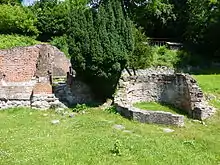 The ruins of Antvorskov Monastery.
MuseumsThere are a number of museum in the municipality.  Slagelse Museum.
Trelleborg.2.111031.ajb.jpg.webp) Trelleborg ring castle. Trelleborg is a museum and ring castle located west of Slagelse, between the villages of Hejninge, Gammel Forlev and Næsby ved Stranden. The ring castle was built around year 980 by Harald Bluetooth. The museum exhibits items and discoveries from the ring castle, and educates about the vikings and the Viking Age. The remnants of the ring castle are associated with the museum, and viking battle reenactment occasionally take place around the ring castle. A yearly viking-themed market takes place in Trelleborg's grounds, and also includes a large viking battle reenactment. [54][55] Slagelse Municipality and the Danish National Museum are funding a project to rebuild part of the ring castle. The project is expected to be finished in 2022. [56] PanzerMuseum East A T34/85 tank on display at PanzerMuseum East. PanzerMuseum East is a museum for military vehicles located 12 km south-east of Slagelse in the small village of Fladholte. The museum holds the largest private collection of military vehicles in the Nordic Countries. The owner of the museum is Allan Pedersen, who opened the museum in 2014. Most of the vehicles and exhibited items in the museum have been restored by Pedersen, who opened the museum after having privately owned and restored the collection for years. The museum span 4,500 km², and include a large park area with 3 shelter groups. In the park are also nordmann fir available during christmas for christmas trees. The museum hosts a yearly market known as History and Lifestyle (Danish: Historie og Livsstil), which takes place in the park surrounding the museum. [57][58][59] The museum focuses primarily on military vehicles, though also display military uniforms and a variety of military memorabilia. Vehicles in the museum include T-72, BMP-1, OT-90, UAZ-469, ZIL-130, LuAZ-967 and more. [60] There are three aircraft in the museum, two helicopters and a passenger plane. The helicopters are a Mi-24P Hind helicopter and a Hip Mi-8 helicopter. The passenger plane is a Bac 1-11.[61] Castles and manorsThe important central location of the municipality, in terms of agriculture and crossing of the Great Belt, has made it an ideal location for manor houses. Today there are still many manors scattered around the municipality. 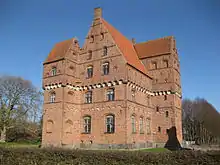 Borreby Castle.
 Taarnholm Manor.
Holsteinborg.JPG.webp) Holsteinborg Castle. Holsteinborg is a manor and castle located south of Rude, north-west of Bisserup and north-east of Glænø. Holsteinborg has existed since at least the early 1300s, though a castle has likely been located at Holsteinborg's location since the 1100s, where it would have been a defensive castle. In the 1300s Holsteinborg was named Braade. It was owned by the church until 1536 where it was taken by the crown. In 1562 it was sold off to Niels Trolle, brother of Herluf Trolle. Niels Trolle died in 1565 in the Seven Years' War, and Braade was inherited by his widow and children. One of his children, Børge Trolle, bought out the other heirs and renamed the manor to Trolholm. It remained under the Trolle family until 1707, where it was sold to Ulrich Adolph Holstein, who renamed the manor to Holsteinborg. He also owned the manors of Snedinge and Fyrendal. Both of these came under Holsteinborg in 1708. It has since then remained under ownership of the Holstein-Holsteinborg family.[78] The total area of Holsteinborg's land amount to 1,386 acres. Of these are 800 used for agriculture and 546 for forests.[79] ChurchesEvents Pig roast at the Viking Festival at Trelleborg. Slagelse Celebration Week (Danish: Slagelse Festuge) is a yearly week-long event, which takes place in Slagelse. Through the week there are live music and entertainment, as well as a running race through the city.[80] Sørby Market (Danish: Sørby Marked) is a yearly kræmmermarked - a type of flea market. It takes place in Sørbymagle. Along with the various booths through the market, there are also live music, food and entertainment.[81] Skælskør Ceramics Festival (Danish: Skælskør Keramikfestival) is a yearly arrangement focused around ceramics. The arrangement includes a market and many displays of ceramics by various artists.[82] A yearly viking-themed market takes place on Trelleborg's grounds, and also includes a large viking battle reenactment, as well as various types of entertainment and education.[83] PanzerMuseum East hosts a yearly market known as History and Lifestyle (Danish: Historie og Livsstil), which takes place in the park surrounding the museum. It's a market with focus on lifestyle, with history-focussed entertainment and education.[84] Parishes Parishes of Slagelse Municipality. There are 41 parishes in Slagelse Municipality. Shown in the table below are the populations of each parish, as well as the percentage of that population that are members of the Church of Denmark. All numbers are from 1 January 2020.
Symbols Coat of Arms of Slagelse Municipality. The coat of arms of Slagelse Municipality shows the Great Belt Bridge in green on white background, with blue wavy lines under the bridge to represent the Great Belt. The bridge represents cooperation and balance with the surrounding nature. It also shows the municipality as a forward-looking municipality with high ambitions, with people and technological progress in focus. It is also meant to be a clearly distinguishable feature. It was adopted in 2009.[126] The coat of arms doesn't resemble any previous coat of arms from the area and is a unique design from 2009. Below are all coats of arms of the cities of the municipality.
Notable residentsPublic thought
Politics
Artisanry and construction
Art
Sport
References
External links
| |||||||||||||||||||||||||||||||||||||||||||||||||||||||||||||||||||||||||||||||||||||||||||||||||||||||||||||||||||||||||||||||||||||||||||||||||||||||||||||||||||||||||||||||||||||||||||||||||||||||||||||||||||||||||||||||||||||||||||||||||||||||||||||||||||||||||||||||||||||||||||||||||||||||||||||||||||||||||||||||||||||||||||||||||||||||||||||||||||||||||||||||||||||||||||||||||||||||||||||||||||||||||||||||||||||||||||||||||||||||||||||||||||||||||||||||||||||||||||||||||||||||||||||||||||||||||||||||||||||||||||||||||||||||||||||||||||||||||||||||||||||||||||||||||||||||||||||||||||||||||||||||||||||||||||||||||||||||||||||||||||||||||||||||||||||||||||||||||||||||||||||||||||||||||||||||||||||||||||||||||||||||||||||||||||||||||||||||||||||||||||||||||||||||||||||||||||||||||||||||||||||||||||||||||||||||||||||||||||

